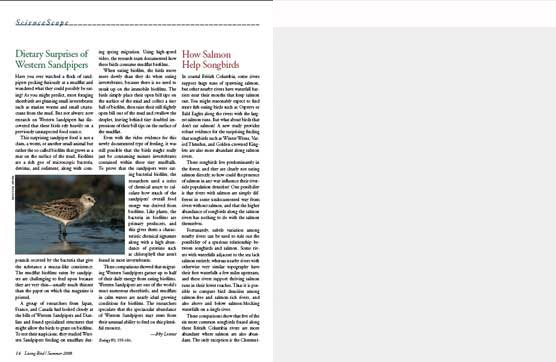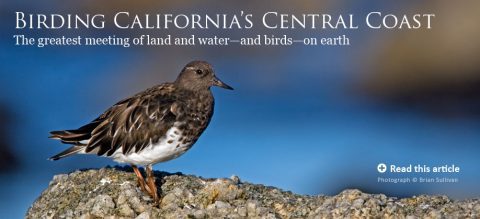Dietary Surprises of Western Sandpipers
By Irby Lovette, director of the Fuller Evolutionary Biology Program July 15, 2008
Have you ever watched a flock of sandpipers pecking furiously at a mudflat and wondered what they could possibly be eating? As you might predict, most foraging shorebirds are gleaning small invertebrates such as marine worms and small crustaceans from the mud. But not always: new research on Western Sandpipers has discovered that these birds rely heavily on a previously unsuspected food source.
This surprising sandpiper food is not a clam, a worm, or another small animal but rather the so-called biofilm that grows as a mat on the surface of the mud. Biofilms are a rich goo of microscopic bacteria, detritus, and sediment, along with compounds secreted by the bacteria that give the substance a mucus-like consistency. The mudflat biofilms eaten by sandpipers are challenging to feed upon because they are very thin—usually much thinner than the paper on which this magazine is printed.
A group of researchers from Japan, France, and Canada had looked closely at the bills of Western Sandpipers and Dunlins and found specialized structures that might allow the birds to graze on biofilms. To test their suspicions, they studied Western Sandpipers feeding on mudflats during spring migration. Using high-speed video, the research team documented how these birds consume mudflat biofilms.
When eating biofilm, the birds move more slowly than they do when eating invertebrates, because there is no need to sneak up on the immobile biofilms. The birds simply place their open bill tips on the surface of the mud and collect a tiny ball of biofilm, then raise their still slightly open bill out of the mud and swallow the droplet, leaving behind tiny doubled impressions of their bill tips on the surface of the mudflat.
Even with the video evidence for this newly documented type of feeding, it was still possible that the birds might really just be consuming minute invertebrates contained within these tiny mudballs. To prove that the sandpipers were eating bacterial biofilm, the researchers used a series of chemical assays to calculate how much of the sandpipers’ overall food energy was derived from biofilms. Like plants, the bacteria in biofilms are primary producers, and this gives them a characteristic chemical signature along with a high abundance of proteins such as chlorophyll that aren’t found in most invertebrates.
These comparisons showed that migrating Western Sandpipers garner up to half of their daily energy from eating biofilms. Western Sandpipers are one of the world’s most numerous shorebirds, and mudflats in calm waters are nearly ideal growing conditions for biofilms. The researchers speculate that the spectacular abundance of Western Sandpipers may stem from their unusual ability to feed on this plentiful resource.
Reference: Kuwae et al. Biofilm grazing in a higher vertebrate: the Western Sandpiper Calidris mauri. Ecology 89:599-606 (2008).

All About Birds
is a free resource
Available for everyone,
funded by donors like you
American Kestrel by Blair Dudeck / Macaulay Library



